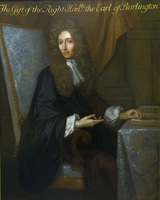Items
Tag
painting
-
 Portrait of Queen Mary II of England (1662 - 1694) Mary was born on April 30, 1662, during the reign of her uncle, Charles II. Her father, James, was first in line to the throne but he was Catholic, which made him unpopular in England. As a result, Charles required Mary to be raised as a Protestant. Three years later, James succeeded Charles, but he was deposed in the Glorious Revolution of 1688, where Mary and her husband as well as first cousin, William of Orange, succeeded him in 1689. Mary was devoted to her husband and reluctant to assume power in his absence, but she proved to be a strong and capable monarch when the need arose. The couple had no children; there is speculation that an early miscarriage permanently impaired Mary’s ability to have children. She was extremely devout and dedicated much of her time to ecclesiastical affairs. In addition, Mary endowed the College of William & Mary in 1692, helped found the Society for Promoting Christian Knowledge, and the Royal Hospital for Seamen. Mary was tall and apparently fit, but in 1694 she contracted smallpox. She died on December 28, 1694. William was devastated and reigned on as sole monarch until his death in 1702.
Portrait of Queen Mary II of England (1662 - 1694) Mary was born on April 30, 1662, during the reign of her uncle, Charles II. Her father, James, was first in line to the throne but he was Catholic, which made him unpopular in England. As a result, Charles required Mary to be raised as a Protestant. Three years later, James succeeded Charles, but he was deposed in the Glorious Revolution of 1688, where Mary and her husband as well as first cousin, William of Orange, succeeded him in 1689. Mary was devoted to her husband and reluctant to assume power in his absence, but she proved to be a strong and capable monarch when the need arose. The couple had no children; there is speculation that an early miscarriage permanently impaired Mary’s ability to have children. She was extremely devout and dedicated much of her time to ecclesiastical affairs. In addition, Mary endowed the College of William & Mary in 1692, helped found the Society for Promoting Christian Knowledge, and the Royal Hospital for Seamen. Mary was tall and apparently fit, but in 1694 she contracted smallpox. She died on December 28, 1694. William was devastated and reigned on as sole monarch until his death in 1702. -
 Portrait of King William III of England (1650 - 1702)
Portrait of King William III of England (1650 - 1702)
-
 Portrait of Robert Boyle Donated by the sitter’s nephew, the Third Earl of Burlington, in 1732, this portrait of celebrated scientist Robert Boyle was the first work of art acquired by The College of William and Mary. Boyle was renowned for the discovery, later known as “Boyle’s Law,” of the mathematical relationship between the pressure and volume of a gas. Upon his death, funds from his estate at Brafferton Manor in Yorkshire, England, founded the first Indian school in the New World, located at the College and named “Brafferton” after Boyle’s manor house. James Worsdale, a student of Sir Godfrey Kneller, based this work on a 1689 portrait of Boyle by Johann Kerseboom, a German-born artist active in England in the late 17th century and the first decade of the 18th century.
Portrait of Robert Boyle Donated by the sitter’s nephew, the Third Earl of Burlington, in 1732, this portrait of celebrated scientist Robert Boyle was the first work of art acquired by The College of William and Mary. Boyle was renowned for the discovery, later known as “Boyle’s Law,” of the mathematical relationship between the pressure and volume of a gas. Upon his death, funds from his estate at Brafferton Manor in Yorkshire, England, founded the first Indian school in the New World, located at the College and named “Brafferton” after Boyle’s manor house. James Worsdale, a student of Sir Godfrey Kneller, based this work on a 1689 portrait of Boyle by Johann Kerseboom, a German-born artist active in England in the late 17th century and the first decade of the 18th century.